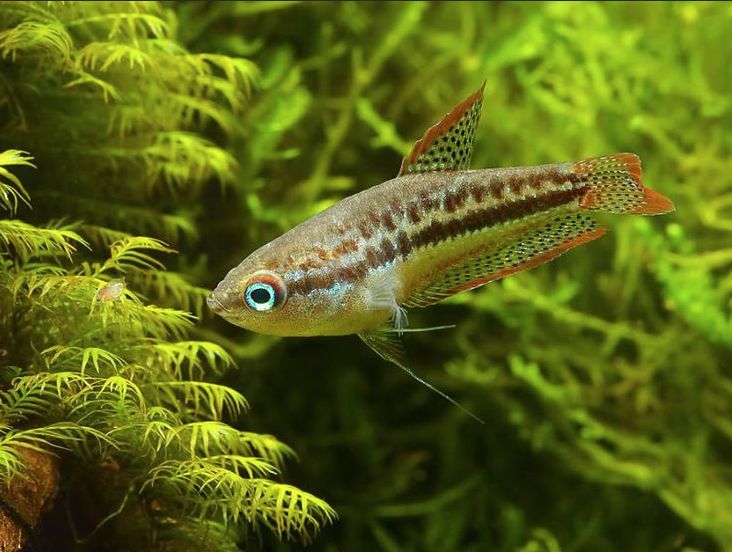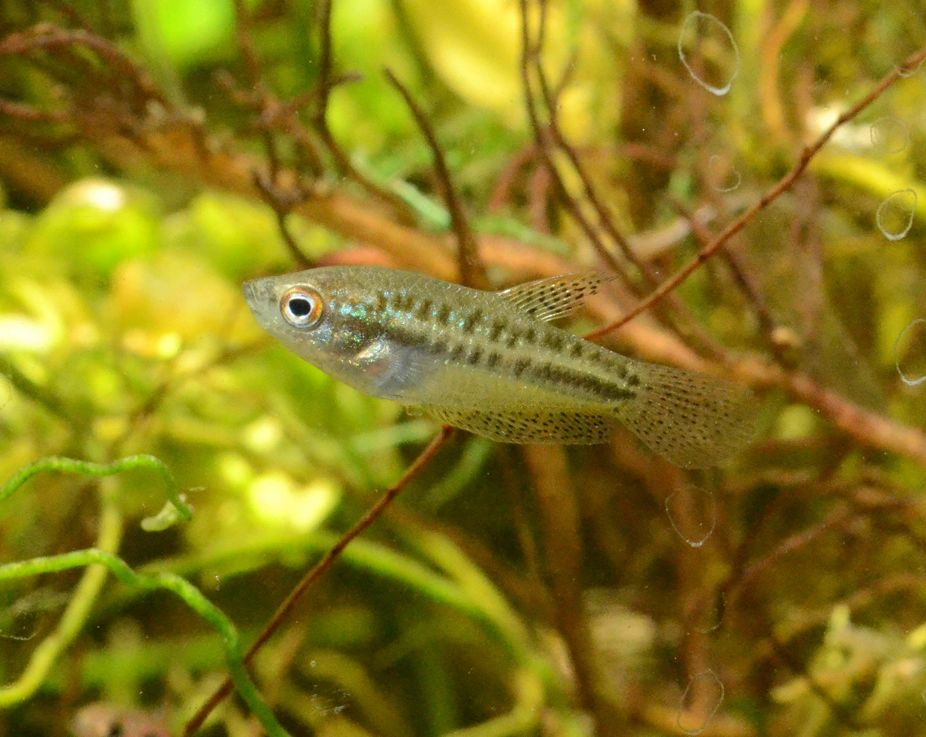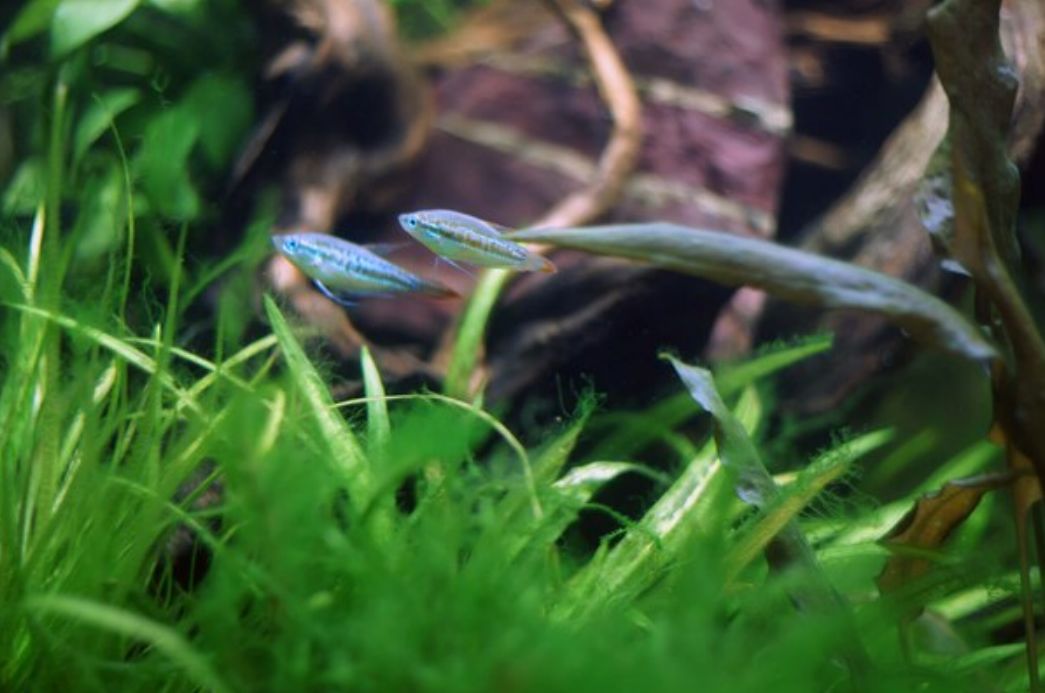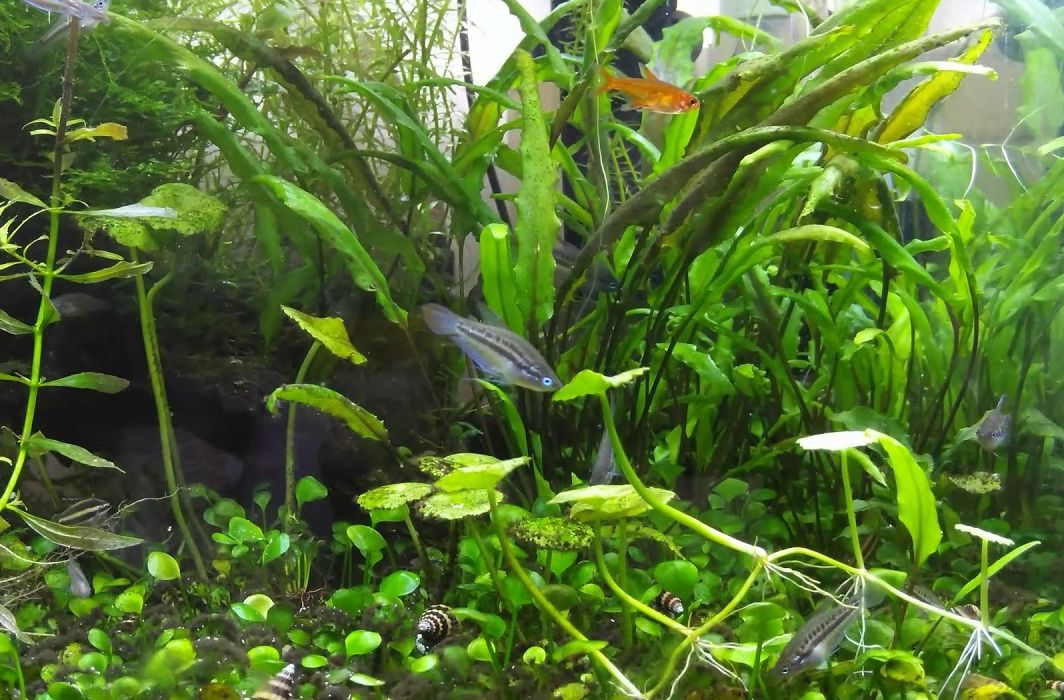Sparkling gourami (Trichopsis pumila) is a captivating yet often overlooked fish in home aquariums. Unlike its more vibrant relatives, the sparkling gourami features subtle beauty that may not immediately capture attention. The name “pumila,” derived from Latin, means “dwarf,” aptly reflecting the species’ small size and delicate stature.
This species is an excellent choice for community tanks due to its peaceful nature. They thrive in well-planted environments with plenty of hiding spots, making them ideal for beginner aquarists looking to create a harmonious aquatic habitat.

Contents
Habitat in the wild
The sparkling gourami, scientifically known as Trichopsis pumila, is a small, colorful freshwater fish that belongs to the gourami family (Osphronemidae). This charming species is native to the warm, slow-moving waters of Southeast Asia, specifically in countries like Thailand, Cambodia, and Vietnam. In its natural habitat, the sparkling gourami thrives in small streams, ponds, marshes, and flooded areas characterized by dense vegetation and warm, shallow waters.
Sparkling gouramis prefer densely planted environments, where they can find shelter among aquatic plants and submerged vegetation. One remarkable adaptation of this species is its ability to survive in challenging conditions, as they belong to the climbing perch family. This means they can breathe atmospheric air, allowing them to inhabit waters with low oxygen levels.
In the wild, sparkling gouramis feed primarily on small insects and other surface-dwelling organisms that fall onto the water’s surface. Their typical habitats are shallow forest ponds with slow or still water, known as lentic environments. During the rainy season, these ponds can overflow and connect to form larger hydrological systems, providing the gourami with a rich and diverse environment.
For aquarists, replicating their natural habitat in a home aquarium is essential for their well-being. Including plenty of plants like java moss or water wisteria can help create a comfortable environment for sparkling gouramis, enhancing their health and vibrancy.

Description
Size
Sparkling gouramis are relatively small freshwater fish, typically growing to a length of about 1.5 to 2 inches (3.8 to 5 centimeters). This modest size makes them an ideal choice for aquarium enthusiasts, particularly for those with limited space. They thrive in smaller tanks, requiring less swimming area, which allows aquarists to create cozy, well-planted environments that mimic their natural habitat.
Their diminutive size also enhances their charm, making them perfect for nano or planted aquarium setups. In such environments, sparkling gouramis can display their vibrant colors and engaging behaviors, adding beauty and life to any tank. Despite their small stature, they are delightful fish that offer a captivating viewing experience.
Lifespan
The average lifespan of sparkling gouramis in captivity typically ranges from 3 to 5 years. However, with exceptional care, some individuals may live slightly longer, reaching up to 6 years or even more in rare cases.
Body
Its body is predominantly a rich brown color, adorned with an array of small, shimmering light blue spots that create a stunning contrast and give it an ethereal quality. The fins are also light blue, featuring vibrant red edges and intricate red patterns that further enhance its beauty. This combination of colors not only makes the fish visually appealing but also serves as a form of communication among individuals.
One of the most captivating features of the sparkling gourami is its striking blue eyes, which are framed by thin red borders, enhancing its allure. The eyes are particularly prominent and reflect light beautifully, adding to the fish’s charm. While its body shape is somewhat similar to that of a betta fish, the sparkling gourami possesses shorter fins, which contribute to its compact and elegant appearance.
Males are particularly distinctive, showcasing pointed fins that extend gracefully from their bodies and a prominent red stripe that runs along the length of their sides. This bold coloration is often more pronounced during breeding displays, making males a stunning sight in a well-maintained aquarium. The vibrant colors of the males not only attract females but also play a significant role in social interactions, signaling health and vitality.
In terms of size, sparkling gouramis typically grow to a maximum length of about 2 inches (5 centimeters), making them one of the smaller members of the gourami family. Their petite size allows them to thrive in smaller tanks, making them a popular choice for aquarium enthusiasts who wish to create a tranquil community environment.
Interestingly, the intensity of the blue and red hues in sparkling gouramis can vary based on environmental factors such as lighting and water conditions. This adaptability makes them even more intriguing to keep. During breeding, males display more vibrant colors and engage in elaborate courtship behaviors, showcasing their beauty and charm even further.
Moreover, males can display competitive behaviors, especially during breeding season, where their vibrant colors and fin shapes play a significant role in attracting females. Observing these interactions can be a rewarding experience for aquarists, as it highlights the natural behaviors of this fascinating species.
| Characteristic | Description |
|---|---|
| Scientific Name | Trichopsis pumila |
| Common Name | Sparkling Gourami, pygmy gourami |
| Family | Osphronemidae |
| Origin | Southeast Asia (Thailand, Cambodia, Vietnam, Laos) |
| Size | Up to 1.5 to 2 inches (3.8 to 5 cm) |
| Coloration | Males: Vibrant blue or green with iridescence |
| Females: Less colorful, more subdued appearance | |
| Behavior | Peaceful, non-aggressive, prefer slow-moving waters |
| Diet | Omnivorous; small insects, zooplankton, plant matter |
| Habitat | Slow-moving or still waters with dense vegetation |
| Water Parameters | pH: 6.0 to 7.0, Temperature: 75°F to 82°F (24°C to 28°C) |
| Tank Size | Around 10 gallons (40 liters) or more |
| Substrate | Fine-grain substrate like sand or small pebbles |
| Plants | Live or artificial plants for hiding and cover |
| Lighting | Subdued lighting, use low-intensity or floating plants |
| Filtration | Good quality filtration with low-flow option |
| Tank Mates | Peaceful and small fish; avoid aggressive species |
| Breeding | Bubble nest builders; male guards and protects eggs |

Keeping in a tank
From time to time, you may hear soft sounds emanating from the tank, reminiscent of a field cricket chirping or the gentle creak of a door. These unique sounds are produced by sparkling gouramis during their mating rituals, where excited males engage in a specific growl to attract females. This vocalization adds an enchanting layer to the aquarium experience, making it even more engaging for aquarists.
In my own tank, the sparkling gouramis often “sing” in the evenings, particularly when the tank lighting is turned off but the room remains illuminated. This creates a cozy ambiance that seems to stimulate their playful behavior. During this time, they embark on their mating games, swimming gracefully together as they spread their fins and engage in their characteristic growling. The combination of their vibrant colors and delightful sounds creates a captivating spectacle that highlights the social interactions of these fascinating fish.
The sounds produced by sparkling gouramis serve as a form of vocal communication, playing a crucial role in their mating rituals and social interactions. Males use these growls to signal their readiness to breed and to establish their presence within the tank. This behavior is not only a testament to their vibrant personality but also an indicator of a healthy, active environment.
Interestingly, the tendency to vocalize more in the evening can be linked to their natural behaviors in the wild. In their native habitats, these fish may become more active during twilight hours, when the lighting conditions are similar to those in a dimly lit aquarium. The difference in lighting cues them to increase their activity levels, leading to more vocalizations.
Furthermore, the sounds are part of a broader set of mating displays. During courtship, males not only produce sounds but also exhibit vibrant colors and elaborate fin displays, further enhancing their appeal to potential mates. The sight of a male spreading his fins while emitting growls creates a striking visual and auditory spectacle, reflecting their health and vitality.
Providing sparkling gouramis with ample hiding spaces and plants can help encourage these vocalizations and social interactions. A well-planted aquarium not only offers security but also promotes natural behaviors, allowing these fish to thrive and engage in their enchanting rituals.
Tank decor
Considering the wide natural habitat of the sparkling gourami, it’s clear that its adaptability to varying environmental conditions is a biological trait that contributes to its popularity among aquarists. To create an ideal environment, it is best to keep these fish in small, densely planted tanks with a school of 4 to 8 individuals. A higher ratio of females is recommended, as males tend to be more territorial and can display aggressive behavior towards one another.
Creating a suitable habitat involves establishing slow water flow and providing ample hiding spaces. A thickly planted tank with dim lighting, along with floating plants on the water surface, creates a perfect environment for sparkling gouramis. These conditions mimic their natural habitat, allowing them to thrive and exhibit natural behaviors.
Conversely, if the tank is equipped with overly bright lighting or contains large, aggressive tank mates, the sparkling gourami may feel stressed and uncomfortable. Under such conditions, these fish tend to retreat and hide from their tank mates, losing their vibrant appearance and overall activity levels. It is essential to strike a balance in tank dynamics to ensure the health and happiness of the sparkling gourami.
Additionally, it’s important to remember that sparkling gouramis breathe atmospheric air from the water surface. This characteristic necessitates that they have unobstructed access to the surface, allowing them to perform this essential function without difficulty.
Water parameters
Here are the recommended water parameters for maintaining a healthy environment for sparkling gouramis:
- Temperature: 75°F to 82°F (24°C to 28°C)
Sparkling gouramis are tropical fish that require a consistent and warm water temperature within this range. Maintaining the temperature is crucial for their metabolic processes and overall well-being. - pH: 6.0 to 7.0
These fish prefer slightly acidic to neutral water conditions. Keeping the pH within this range supports their health and reduces stress, allowing them to thrive in a balanced environment. - Hardness: Soft to moderately hard water
Sparkling gouramis thrive in water with a general hardness (GH) of around 5 to 15 dGH. The right water hardness contributes to their comfort and can enhance their coloration. - Ammonia and Nitrite: 0 ppm
Both ammonia and nitrite are toxic to fish, making it essential to keep these levels at zero to ensure the well-being of your gouramis. Regular water changes and proper filtration systems are critical for achieving and maintaining this standard. - Nitrate: Below 20 ppm
While nitrate is less harmful than ammonia and nitrite, elevated levels can still cause stress in fish. To keep nitrate levels in check, regular water changes are necessary.
When introducing new sparkling gouramis to the aquarium, it is essential to acclimate them slowly to the tank’s water conditions to prevent shock and stress. This gradual acclimatization process helps them adjust to the new environment without undue strain.
Tank size
A small tank is sufficient to keep a couple of sparkling gouramis; however, since it is recommended to maintain them in a school, a larger tank is necessary. While a tank can be quite small, it should be no less than 10 gallons (approximately 40 liters) to accommodate a small group of these fish. Sparkling gouramis are petite, reaching lengths of up to 1.5 to 2 inches (3.8 to 5 cm), which means they do not require excessively large tanks. However, providing ample space for swimming and exploration is crucial for their well-being.
A 10-gallon tank can adequately house a pair of sparkling gouramis, but if you intend to keep multiple fish together, it would be wise to consider a larger tank. This helps reduce territorial behavior and stress, allowing the fish to coexist peacefully. Males, in particular, can be territorial, especially during breeding season, so having enough space and hiding spots can help mitigate aggressive behaviors. The general guideline is to provide at least 2 gallons (about 7.5 liters) of water per fish to ensure they have enough space.

Tank mates
You should keep sparkling gourami separately from other fishes for one more reason. Even if they have peaceful and non-aggressive, but active tank mates, the fish becomes the last one to get the food. Another thing is, that while breeding sparkling gourami unlike other tank fishes looks after their eggs, larvae and juveniles. At that they don’t even try to eat their juveniles, even though there was no food in a tank for a long time.
Here are some suitable tank mates for sparkling gouramis:
- Harlequin Rasboras (Trigonostigma heteromorpha)
- Neon Tetras (Paracheirodon innesi)
- Ember Tetras (Hyphessobrycon amandae)
- Glowlight Tetras (Hemigrammus erythrozonus)
- Black Neon Tetras (Hyphessobrycon herbertaxelrodi)
- Cardinal Tetras (Paracheirodon axelrodi)
- Rummy Nose Tetras (Hemigrammus rhodostomus)
- Dwarf Gouramis (Trichogaster lalius or Trichogaster chuna)
- Celestial Pearl Danios (Danio margaritatus)
- White Cloud Mountain Minnows (Tanichthys albonubes)
- Dwarf Rasboras (Boraras spp.)
- Endler’s Livebearers (Poecilia wingei)
- Guppies (Poecilia reticulata)
- Platies (Xiphophorus spp.)
- Corydoras Catfish (Corydoras spp. – pygmy cory, panda cory, adolfoi catfish)
- Otocinclus Catfish (Otocinclus spp.)
- Bristlenose Plecos (Ancistrus spp.)
Diet
In the wild, sparkling gouramis primarily feed on insects, but in a home aquarium, they can be nourished with both artificial and live food. Once accustomed to their new environment, these fish will readily consume flakes, pellets, and other types of prepared food. However, it is still advisable to provide them with live and frozen food to ensure a well-rounded diet and promote their health and vitality.
To support the growth and development of sparkling gouramis throughout all life stages, it’s important to diversify their diet. Incorporating various types of food, including live, frozen, and high-quality artificial options, will help meet their nutritional needs. This variety not only mimics their natural feeding habits but also encourages active foraging behavior.
It’s best to feed sparkling gouramis small portions two to three times a day to mimic their natural feeding patterns and prevent overfeeding. This frequent feeding schedule helps to replicate their instinctual behavior of foraging throughout the day and ensures they receive adequate nutrition without polluting the water with excess food.
Sparkling gouramis particularly enjoy live foods such as daphnia, brine shrimp, and mosquito larvae. These foods can stimulate their natural hunting instincts and provide essential nutrients. Live food is not only more appealing to them but also enhances their activity levels, making feeding time a more dynamic experience.
To further enrich their environment, offering a varied diet can enhance their activity levels and behaviors, making them more engaging to observe in an aquarium setting. A well-fed sparkling gourami is likely to display vibrant colors and lively interactions, contributing to the overall aesthetic of the aquarium.
In their natural habitat, sparkling gouramis swim through all layers of water; however, they exhibit a distinct preference for the middle and near-surface layers. When designing your aquarium setup, it’s beneficial to create environments that accommodate this behavior, such as adding floating plants or decorations that provide cover and encourage exploration at these water levels.
Gender differences: male vs female
Distinguishing between male and female sparkling gouramis can be quite challenging, but there are several key differences that can help you identify each sex:
Male Sparkling Gourami:
- Coloration: Males are typically more vibrant and colorful than females, displaying iridescent blue or green hues, especially on their flanks and fins. This vibrant coloration is often more pronounced during breeding times.
- Fins: The fins of male sparkling gouramis are usually more elongated and pointed, particularly the dorsal and anal fins, contributing to their striking appearance.
- Stripe Pattern: Males often exhibit vertical stripes that run along their bodies, starting from behind the eye and extending towards the caudal fin. These stripes can become more prominent during courtship.
- Behavior: During breeding, males are known to construct bubble nests at the water surface and actively court females to lay eggs in the nest. They are typically more territorial and may display aggressive behavior towards other males, particularly in confined spaces.
- Size: Males are generally slightly larger than females, though the size difference is not significant.
Female Sparkling Gourami:
- Coloration: Females have a more subdued appearance, often displaying a paler shade of blue or green with less iridescence. This coloration may appear drab compared to that of the males.
- Fins: Female fins are shorter and more rounded than those of males, lacking the elongated, pointed shape that characterizes male fins.
- Stripe Pattern: Females may have faint vertical stripes, but these are less prominent than those found in males, making them harder to distinguish.
- Behavior: Females do not construct bubble nests and are generally less territorial. They tend to be more peaceful and are less likely to exhibit aggressive behavior towards other fish.
- Size: Females are generally slightly smaller than males, but the size difference is minimal.
It’s important to note that the color intensity and patterns of sparkling gouramis can vary based on their mood, environment, and overall health.
Breeding
The sparkling gourami exhibits fascinating breeding behaviors, beginning with the construction of a small nest near the water’s surface or just beneath it. Once the nest is complete, the male invites the female to join him, where they proceed to lay their eggs. From the moment the first eggs are deposited in the nest until the larvae begin to swim independently, the male takes on the crucial role of caregiver, diligently protecting the nest from being swept away by water currents.
To ensure the stability of the nest, the male uses a unique method: he prevents the bubbles from flowing away by gluing them together with a sticky secretion produced by specialized epithelial cells lining his oral cavity. This remarkable adaptation allows the male to maintain the nest’s structure and safeguard the developing eggs. The male often chooses an appropriate location for the nest, considering factors such as water flow and accessibility, ensuring the eggs are well-protected from potential threats.
During their first spawning, sparkling gouramis typically lay a modest number of eggs, usually around 40 to 80. However, with subsequent spawnings, this number often increases slightly. The development time for the eggs, from fertilization to hatching, varies based on the tank’s water temperature, ranging from 36 to 48 hours. In addition to maintaining the nest, males will sometimes gently mouth the eggs to keep them aerated and remove any debris that may accumulate, further ensuring the health of the developing embryos.
Once the larvae emerge, it becomes essential to consider their dietary needs. The newly hatched larvae are incredibly small, measuring about 1.5 mm in length, and require fine-grained food to support their growth. Suitable food options for the larvae include infusoria, liquid fry food, or finely crushed powdered foods that can provide the necessary nutrients for their early development. The survival rate of the larvae can be influenced by the tank environment, including water quality and the presence of suitable food sources.
The male’s parental investment doesn’t end with the hatching; he may continue to protect the larvae for a short period as they start swimming independently. This showcases the strong parental instinct of the species and highlights the importance of a stable environment during this vulnerable phase. While the initial number of eggs is typically lower, experienced breeding pairs may lay significantly more eggs in subsequent spawnings, reflecting their increasing familiarity with the breeding process and enhancing the potential for future generations.